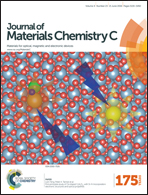The electronic and optical properties of novel germanene and antimonene heterostructures†
Abstract
In this work, the structural, electronic and optical properties of novel atomically thin systems based on germanene and antimonene nanocomposites have been investigated by means of density functional theory. We find that the germanene and antimonene monolayers are bound to each other via orbital hybridization with enhanced binding strength. Most importantly, the band gap opening can be achieved. Our results demonstrate that the AAII pattern has a direct band gap characteristic with a moderate value of up to 391 meV, while the other three patterns have indirect band gaps tunable from 37 to 171 meV. In particular, changing the direction and strength of the external electric field (E-field) can effectively tune the energy gap of the germanene/antimonene bilayer over a wide range even with a semiconductor–metal transition. The work function of the heterobilayer in the AAII pattern which possesses a direct band gap can be tinkered up from −3.21 to 12.33 eV by applying different E-field intensities. In addition, the germanene/antimonene bilayer exhibits more pronounced optical conductivity. The tunable bandgaps and work function together with a superior visible light response capability make the germanene/antimonene bilayer a viable candidate for optoelectronic applications.


 Please wait while we load your content...
Please wait while we load your content...